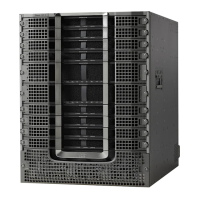Configuration Examples for Fairness Across DOCSIS Interfaces
This section lists the following sample configurations for the Fairness Across DOCSIS Interfaces feature on
a Cisco CMTS router:
Example: Fairness Across DOCSIS Interfaces
The following sample configuration shows Fairness Across DOCSIS Interfaces feature enabled on the router:
Current configuration : 39682 bytes
!
! Last configuration change at 04:30:02 UTC Wed Jan 19 2
! NVRAM config last updated at 04:23:17 UTC Wed Jan 19 2
!
version 12.2
!
cable clock dti
cable acfe enable
!
.
.
.
Example: Maximum EIR Demand Ratio
The following sample configuration shows maximum EIR demand ratio configured on the router:
Building configuration...
Current configuration : 54253 bytes
!
version 12.2
!
cable clock dti
cable acfe enable
cable acfe max-eir-ratio 20
!
The effect of the cable acfe max-eir-ratio command is demonstrated using a simple BG cluster.
!
interface integrated-Cable1/0/0:0
cable bundle 1
cable rf-bandwidth-percent 10
!
interface Wideband-Cable9/0/0:0
cable bundle 1
cable rf-channels channel-list 0
bandwidth-percent 1
end
!
On this RF channel, 20 percent of the bandwidth is reserved by the ‘bandwidth-percent’ allowing Fairness
Across DOCSIS Interfaces feature to use 27 Mbps, that is: (100 - 20) * 90 * 37.5). If the ‘max-eir-ratio’ is
above 100 and the WB interface has 99 active BE flows and the IC interface has only 1 BE flow, then IC
interface gets only 270 kbps, that is 1/(1+99)*27 of the bonus bandwidth. The BE traffic enjoys perfect fairness
here. However, it is not possible to admit a unicast CIR flow beyond 270 kbps on the IC interface, as it would
exceed the bonus bandwidth. If the ‘max-eir-ratio’ is set to 10, then the IC interface is treated to have 99/10
flows on it, resulting in a higher bonus bandwidth allocation. The ‘max-eir-ratio’ is a trade-off between perfect
fairness and CIR utilization.
Cisco cBR Series Converged Broadband Routers Quality of Services Configuration Guide for Cisco IOS XE Fuji
16.7.x
99
Fairness Across DOCSIS Interfaces
Configuration Examples for Fairness Across DOCSIS Interfaces

